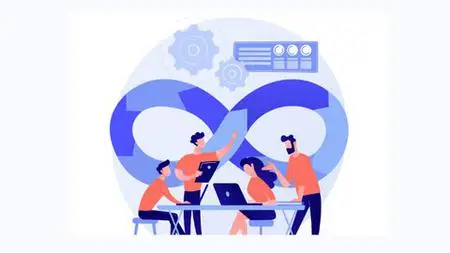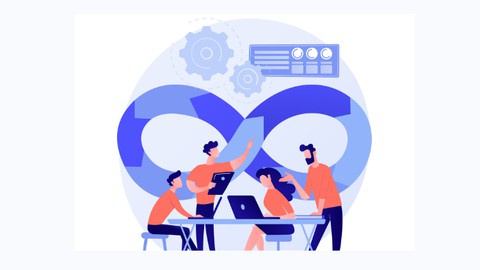Learn Devops From Scratch -Moole Muralidhara Reddy
Published 12/2022
MP4 | Video: h264, 1280x720 | Audio: AAC, 44.1 KHz
Language: English | Size: 8.86 GB | Duration: 22h 42m
Published 12/2022
MP4 | Video: h264, 1280x720 | Audio: AAC, 44.1 KHz
Language: English | Size: 8.86 GB | Duration: 22h 42m
You can learn DevOps tools from scratch i.e Git,Maven,Jenkins,Ansible,Docker , SonarQube, Nexus, Tomcat, Jfrog & Linux
What you'll learn
Once the course is completed, students understands the DevOps flow end to end.
The concepts used in the course can be understandable by the non technical engineers.
It understands the various tools useful for DevOps life
Not only completion of the course it also increases the positivity and one can be ready for applying the DevOps positions.
Requirements
Basic Computer Knowledge
Linux Basics are the prerequisites for this course but it is not mandatory
Windows/Linux OS is mandatory
Want to enhance DevOps Skills
Description
This course has been designed in such a way that even non technical engineers can also understands very well.Once the course is completed, you can gain the confidence and positivity and will be useful for your organization to strengthen your project and can implement various of the tools and makes the life easier.I have covered below tools from scratch in English.DevOps OverviewLinux Basic commandsGitMavenNexusJfrog ArtifactorySonarQubeTomcatJenkinsAnsibleDockerCome lets have fun by learningAbout the author:.I am having rich experience in DevOps and Cloud technologies and have done many projects on all varieties of tools which are hot cake in the market.I am passionate about learning new technology and teaching. My courses focus on providing students with an interactive and hands-on experience in learning new technology that makes learning really interesting.I have a wide range of experience in Telecom, Banking, Healthcare, Retail domains.I have been training people in newer technologies, like DevOps, AWS, Kubernetes, Terraform, Rancher, etc. and they have settled in MNC’s and drawing respectable salaries.I have undergone many challenges and changed the entire phase of the projects and mastered in DevOps implementation and many more to go.Certified in AWS, Kubernetes , Terraform, Linux and many to go.
Overview
Section 1: DevOps Overview
Lecture 1 What is Waterfall & Agile Methodology
Lecture 2 What is DevOps
Lecture 3 Creation of AWS account
Lecture 4 Downloading the Putty and Puttygen
Lecture 5 Creation of Linux EC2 instance
Lecture 6 Connecting to the Linux server
Lecture 7 Create and Connecting to the Windows server
Lecture 8 Create and Connecting to the Ubuntu server
Section 2: Linux
Lecture 9 Linux Overview
Lecture 10 Linux Basic commands Part 1
Lecture 11 Linux Basic commands Part 2
Lecture 12 Linux Basic commands Part 3
Lecture 13 Linux Basic commands Part 4
Lecture 14 Linux directory structure
Lecture 15 Working with files
Lecture 16 Working with Directories
Lecture 17 Working with cp & mv command
Lecture 18 Working with soft, hard link and inode number
Lecture 19 Working with File Permissions
Lecture 20 Working with File Ownership
Lecture 21 Working with rm command
Lecture 22 Creating and deleting the users
Lecture 23 Creating and deleting the groups
Lecture 24 Working with head & tail
Lecture 25 Working with top & free command
Lecture 26 Working with YUM command
Lecture 27 Working with RPM command
Lecture 28 Working with tar command
Lecture 29 Working with zip command
Lecture 30 Working with find command
Lecture 31 Working with df , du, kill, ps commands
Lecture 32 Working with nslookup & ifconfig
Lecture 33 Working with echo , env , tac , locate commands
Lecture 34 Working with less , more , wc ,comm commands
Lecture 35 Working with sleep , exit , host , diff commands
Lecture 36 Working with scp , ssh commands
Section 3: Git
Lecture 37 Git Overview
Lecture 38 Installation of git in Linux
Lecture 39 Installation of git in windows
Lecture 40 Overview of Git Workflow
Lecture 41 Working with git init, git config, git log command
Lecture 42 Creation and deletion of git branches
Lecture 43 GitHub Dashboard Overview
Lecture 44 Creation of GitHub account
Lecture 45 Push the code from local to remote
Lecture 46 Changing the existing remote url in local
Lecture 47 Cloning the repository from remote to local in GitBash
Lecture 48 Difference between git pull and git fetch
Lecture 49 Working with git merge & git rebase
Lecture 50 Working with "git reset"
Lecture 51 Working with "git revert"
Lecture 52 Working with .gitignore file
Lecture 53 Working with git diff & git HEAD
Lecture 54 Deletion of GitHub repository
Lecture 55 Deletion of GitHub account
Lecture 56 GitLab Dashboard Overview
Lecture 57 Creation of GitLab account
Lecture 58 Creation of git repository in GitLab
Lecture 59 Deletion of GitLab repository
Lecture 60 Deletion of GitLab account
Lecture 61 Overview of Future branching strategy
Lecture 62 Overview of Release branching strategy
Section 4: Maven
Lecture 63 What is Maven
Lecture 64 Download mobaxterm in Windows
Lecture 65 Installation of maven in Linux
Lecture 66 What is pom.xml
Lecture 67 What is settings.xml
Lecture 68 Types of Maven Repository
Lecture 69 Creation of Java application using maven
Lecture 70 Maven Build Lifecycles
Lecture 71 Creation of web application using maven
Lecture 72 Explore pom.xml options
Lecture 73 Explain about skip test cases & jacoco plugin
Section 5: Nexus
Lecture 74 Nexus Overview
Lecture 75 Installation of nexus in Linux
Lecture 76 Setup Nexus as service in Linux
Lecture 77 Nexus Dashboard Overview
Lecture 78 Creation of users and roles
Lecture 79 Integrating the nexus in maven
Section 6: Jfrog Artifactory
Lecture 80 Jfrog Artifactory Overview
Lecture 81 Installation of Jfrog Artifactory in Linux
Lecture 82 Jfrog Artifactory Dashboard Overview
Lecture 83 Creation of users and groups in Jfrog Artifactory
Lecture 84 Integrating the Jfrog in maven
Section 7: SonarQube
Lecture 85 SonarQube Overview
Lecture 86 Installation of SonarQube in Linux
Lecture 87 Setup Sonar as service in Linux
Lecture 88 SonarQube dashboard overview
Lecture 89 Creation of users in SonarQube
Lecture 90 Integrating the SonarQube in maven
Section 8: Tomcat
Lecture 91 What is Tomcat
Lecture 92 Types of Tomcat Roles
Lecture 93 Installation of tomcat in Linux
Lecture 94 Setup tomcat as service in Linux
Lecture 95 Deploy web application war file in Tomcat
Section 9: Jenkins
Lecture 96 Jenkins Overview
Lecture 97 How many ways to install Jenkins in Linux
Lecture 98 Installation of Jenkins using yum
Lecture 99 Installation of Jenkins using war file
Lecture 100 Jenkins Dashboard Overview
Lecture 101 How to Reset Jenkins users Password
Lecture 102 Exploring the options under manage Jenkins
Lecture 103 Creation of a Jenkins job
Lecture 104 Integrating the Maven in Jenkins
Lecture 105 Integrating the nexus in Jenkins
Lecture 106 Integrating the Jfrog with Jenkins
Lecture 107 Integrating the SonarQube with Jenkins
Lecture 108 Deploying web application war file in tomcat using Jenkins
Lecture 109 Creation of Slack account
Lecture 110 Send notifications from Jenkins to Slack
Lecture 111 Creation of Users in Jenkins
Lecture 112 Take the backup and restore the Jenkins
Lecture 113 Working with restart , safeRestart , copy and move jobs
Lecture 114 Difference Between build periodically , pollSCM , webhook
Lecture 115 Setting up the Build Pipeline
Lecture 116 What is master and slave node
Lecture 117 Setting up the Linux slave node in Jenkins
Lecture 118 Setting up the windows slave node in Jenkins
Lecture 119 Jenkins Pipeline Overview
Lecture 120 What are the fields available in declarative pipeline
Lecture 121 Exploring the options in declarative pipeline Part 1
Lecture 122 Exploring the options in declarative pipeline Part 2
Lecture 123 Exploring the options in declarative pipeline Part 3
Lecture 124 Build and push to Artifactory
Lecture 125 Build & Deploy to Tomcat
Lecture 126 Build & Deploy to Tomcat using Jenkinsfile
Section 10: Ansible
Lecture 127 Ansible Overview
Lecture 128 Installation of ansible in Linux
Lecture 129 Ansible Workflow
Lecture 130 Overview of ansible ad-hoc command
Lecture 131 Working with ansible ad-hoc commands with example Part 1
Lecture 132 Working with ansible ad-hoc commands with example Part 2
Lecture 133 SSH Overview
Lecture 134 Setting up the SSH connection manually
Lecture 135 Ansible Modules Overview
Lecture 136 Overview of Ansible Playbook
Lecture 137 Installation of httpd & git using ansible playbook
Lecture 138 Exploring the with_items
Lecture 139 Exploring the variables
Lecture 140 Exploring the tags
Lecture 141 Installation of tomcat using ansible playbook
Lecture 142 Overview of Ansible role
Lecture 143 Installation of httpd using ansible role
Lecture 144 Ansible vault Part 1
Lecture 145 Ansible vault Part 2
Section 11: Docker
Lecture 146 Difference between Containerization and Virtual machines
Lecture 147 Docker Overview
Lecture 148 Exploring the available docker components
Lecture 149 Installation of docker in Linux
Lecture 150 Dockerfile Overview
Lecture 151 Dockerfile Demo Part 1
Lecture 152 Dockerfile Demo Part 2
Lecture 153 Overview of DockerHub
Lecture 154 DockerHub Dashboard Overview
Lecture 155 What is docker storage
Lecture 156 What is docker image
Lecture 157 Docker image commands Part 1
Lecture 158 Docker image commands Part 2
Lecture 159 What is docker container
Lecture 160 Docker container commands Part 1
Lecture 161 Docker container commands Part 2
Lecture 162 Docker container commands Part 3
Lecture 163 docker network concept
Lecture 164 docker volume concept
Software Engineers,Freshers,Aspirants to shift career to DevOps



